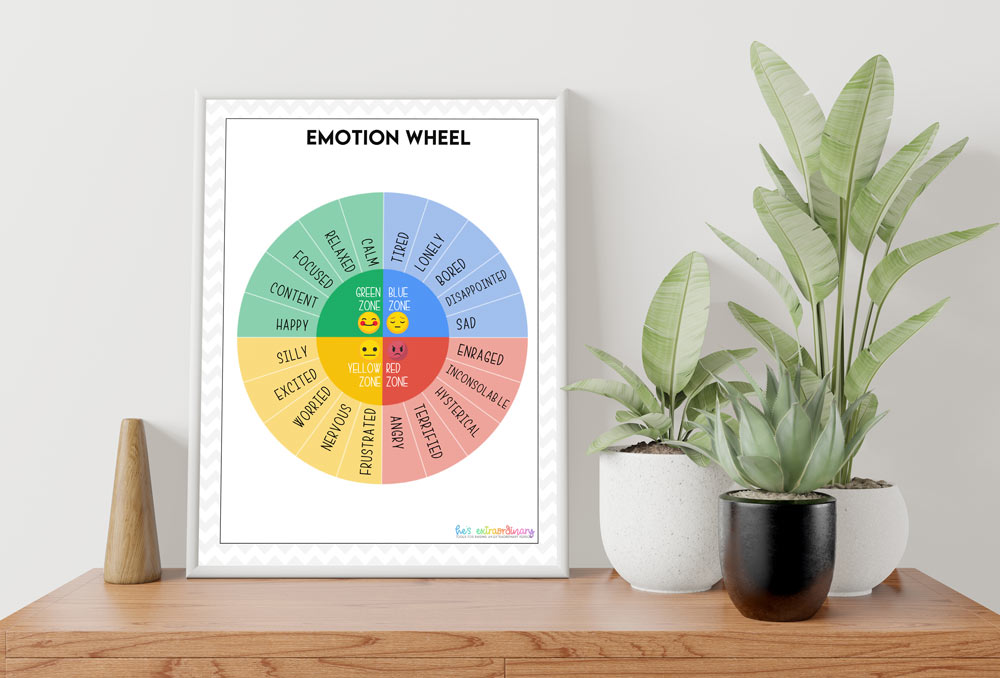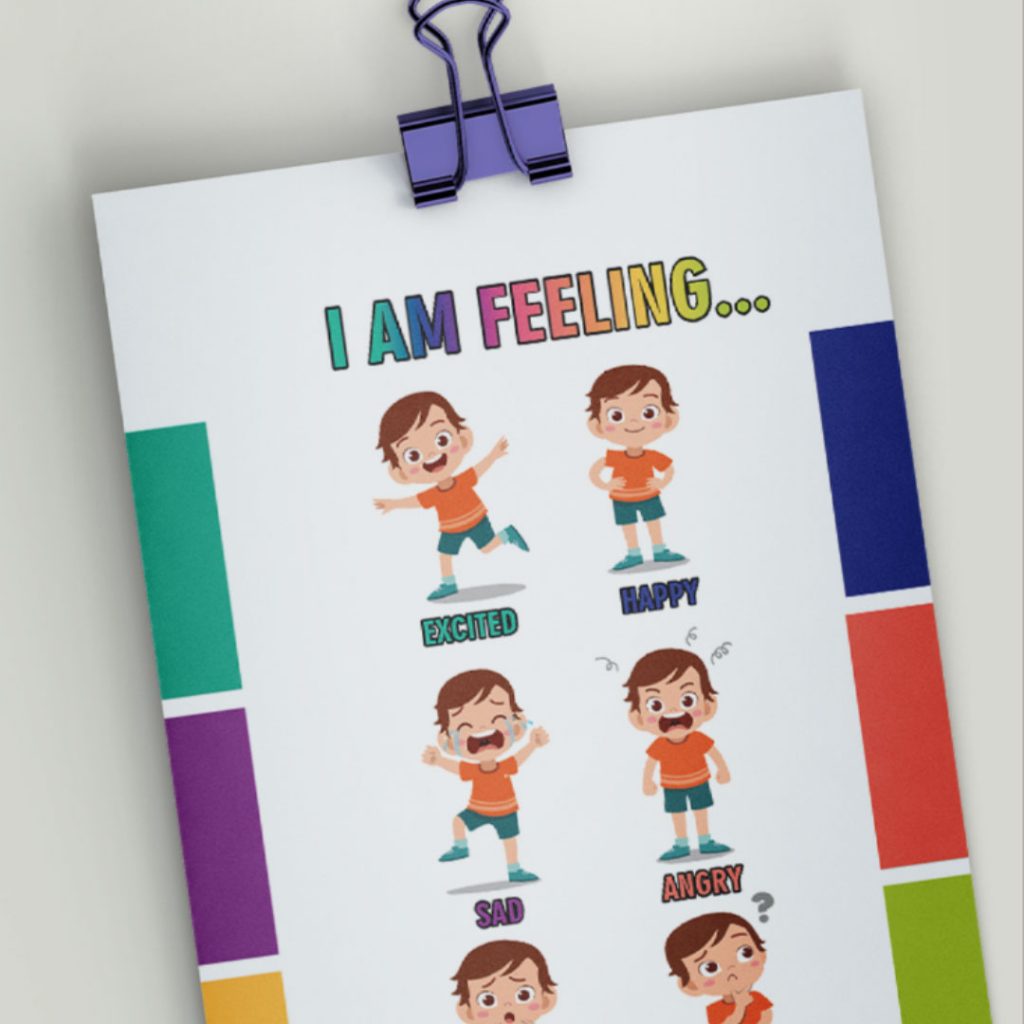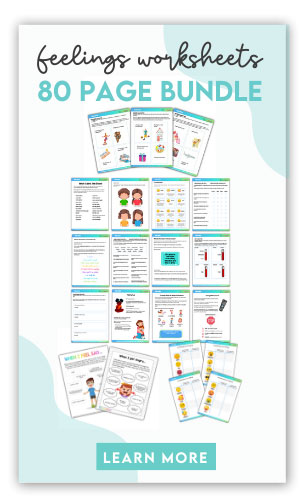Emotion Chart: A Simple Way To Check In On Your Child’s Feelings
What’s inside this article: Tips, as well as free printable emotions charts for kids, to help children learn how to identify and express their feelings.
Figuring out what your child is feeling, and why they feel that way, can be hard. It may be even more difficult for your child. An emotion chart can help your child express themselves, and help you check in on them.
Often children don’t even know what emotion they’re feeling so they simply react to the physiological responses their body is having.
If your child is also struggling to communicate what’s wrong, what they want and need, or how they feel, they may get frustrated.
That frustration from the inability to communicate, along with big feelings such as anger, fear, worry, often lead to outbursts and meltdowns.
Teaching Children to Identifying Emotions
It’s important to teach your children how to identify their own emotions (and others’). Although keep in mind, even if they know how to identify what they’re feeling, that doesn’t mean they’ll be able to or be comfortable communicating it with others.
According to Kids Helpline, children who learn how to express their feelings are more likely to:
- Display fewer behavior problems
- Do better in school
- Be empathetic and supportive of others
- Develop healthy coping skills and resilience
- Have a positive self-image
- Have more positive and stable relationships with others
- Have good mental health
So, how can you teach your children to identify their emotions?
Talk About Your Feelings, and Others’ Feelings
How things make you and other people feel should be a regular part of how you communicate with your child. Regularly hearing about how different events affect your emotions will help your child start making their own connections about their feelings.
Share both good feelings and bad feelings with your child. For example, use positive reinforcement like “It makes me feel happy when I see you sharing with your sister“. But also explain how inappropriate behaviors make you feel, such as “It makes me feel sad when you say that I’m mean.”
Also, talk about how you think other people are feeling. When you’re watching TV with your child, for example, make comments such as “That person is smiling, they must feel happy”, or “That person looks like he feels very mad, look at his eyebrows.”
If your child uses the Zones of Regulation at school, then you can also use printable zones of regulation activities. You can find some Zone’s worksheets here.
If you’re out shopping and hear a baby cry, ask your child why they think the baby might be crying. This gives them a chance to think about how the baby is feeling. They could be feeling sad because they’re tired or hungry, too hot or too cold, as a few examples.
Name Your Child’s Feelings
Along with talking about your own feelings, also do your best to identify your child’s feelings.
For kids, sometimes just hearing a name for what they are feeling can be comforting. Especially if they struggle to identify their emotions.
For example, ” When your brother didn’t want to play you must have felt sad. It seems unfair, I know. Maybe you will feel better if we find something else for you to play with”
Over time this will help your child learn to identify their feelings and express them with words.
Use Easy to Understand Emotive Words
As your child begins learning to identify their emotions, use easy to understand emotive words. Your child needs to understand these before you can move on to more descriptive emotive words.
For example, use the word “mad” to describe irritation, anger, annoyance, frustration, etc.
| Easy Emotive Words | Complex Emotive Words |
| Happy | Content, relaxed, peaceful, elated, overjoyed, excited, carefree, silly, gitty, ecstatic, gratified |
| Sad | Upset, woeful, grief, melancholy, heartbroken, defeated, rejected, disappointed, dissatisfied, remorseful |
| Mad | Irritated, angry, annoyed, frustrated, livid, fuming, enraged, cross, resentful, irate, displeased, irked, bothered |
| Tired | Worn out, fatigued, exhausted, overtired, weary, drained, unrested |
Emotion Wheel
You can use this emotion wheel as a transition tool to help teach your child more complex emotive words.
The wheel is based on the Zones of Regulation and has 20 different emotions on it.

Create a Visual of How Emotions Feel Physiologically
Every emotion has a corresponding physiological response in our bodies. For example, every time I feel scared my heart starts to beat really fast, my face and hands feel ice cold, and I get “butterflies” in my stomach.
Download this free printable for “Mapping Your Feelings” and complete it with your child for different feelings.
Having a visual can help reinforce to your child what emotions cause these various sensations in the body, making it easier for your child to identify their own feelings.
We recently did this body chart activity to encourage the kids to think about how their emotions feel.
We also did an activity about what anger feels like and you can download and print that here, and well as an activity for what sadness feels like.

Talking About Feelings
Just because your child knows how to identify their own emotions or other people’s emotions, does not mean they’re able to talk about their feelings.
Why is it so darn hard to get your child to tell you what’s going on?
- Vulnerability. For starters, telling someone how you are feeling puts you in a vulnerable position. Yes, even for a child talking to their parents. A lot of adults struggle to share their emotions with loved ones.
- Struggling to find the right words. Have you ever known exactly how you felt in your head but struggled to find the right words to describe it to someone else? Children struggle with this even more so, which means they just may not have the words to tell you. For older kids, it may be easier for them to write their feelings down.
- They don’t want to be chastised. Even though we have the best intentions, children often feel chastised by their parents when trying to talk to them. Usually, we are just trying to help, but sometimes what we need to do is just stop and listen. For example, your child tries to tell you that she “can’t stand her teacher” and you say “well if you make sure your homework is passed in on time this wouldn’t happen.” Chances are your child knows that already. Sometimes they need to be able to vent without receiving advice.
Emotion Chart
Using this emotion chart gives your child a way to express how they feel visually instead of verbally.
It’s specific enough to give you an idea of why they’re feeling how they feel, as opposed to some of the other emotion charts like the emotion thermometer for example.
Once you’ve used this emotion chart to get an idea of how your child is feeling and what area of their life may be causing this, you can start devising your plan to figure out what’s wrong.
Most children find it easier to talk about events and experiences than emotions. They’re tangible things that have happened and can be described.
For example, if your child circled the angry face under ” How are your friendships going?” you could start the conversation by saying “Did you get into a fight with your best friend?”
Or you can skip finding out why and just move on to helping your child find a healthy coping strategy.
For example, if your child circled that they feel sad, rather than asking questions about what happened, you can just tell them “Whenever I feel sad, I always feel better after I cuddle up with my blanket and watch my favorite TV show”.
Check out this list of 119 ideas and activities for teaching self-regulation and healthy coping skills.
This gives you a chance to comfort your child, making them feel better. Without making your child feel hounded by questions, overwhelmed, vulnerable or uncomfortable.
Then, hopefully, your child will share with you when they’re ready. But if they don’t, that’s okay too. Sometimes we need to face our problems all on our own, and that’s a big step towards independence.
Feelings Check-InAnother Feelings Chart
If the first chart is too complex for your child, or if you just don’t need the different categories, you can also try out this feelings chart for kids.

There are several different emotions on this chart, your child could use a paperclip on the edge of the page to indicate how they’re feeling, or you could laminate it and have them circle how they’re feeling using a dry erase marker.
I also have a mega bundle of printables and digital downloads that help children understand and cope with feelings. You can see samples of everything included here.


